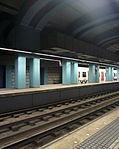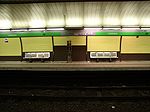Sant Gervasi station

Sant Gervasi is a railway station located under Plaça Molina in the Sarrià-Sant Gervasi district of Barcelona. During off-peak periods it is served by line L6 of the Barcelona Metro. During peak periods, additional services are provided by lines S5 and S55 of the Metro del Vallès commuter rail system, whilst service on line L6 is reduced or removed altogether. All these lines are operated by Ferrocarrils de la Generalitat de Catalunya, who also run the station.The station has twin tracks, with two 80 metres (260 ft) long side platforms. It is located close to Plaça Molina station, on metro line L7. The two stations are connected by a pedestrian tunnel, within the fare paid area of both stations.Due to the renovations at the Gràcia station, commuters wishing to take the L7 line to Avinguda Tibidabo must access it by switching from Sant Gervasi to Plaça Molina.The first Sant Gervasi station opened in 1863 and was situated in a cutting with a station building at ground level. The current station was opened in 1929, when the line serving the station was put underground.
Excerpt from the Wikipedia article Sant Gervasi station (License: CC BY-SA 3.0, Authors, Images).Sant Gervasi station
Via Augusta, Barcelona
Geographical coordinates (GPS) Address Nearby Places Show on map
Geographical coordinates (GPS)
| Latitude | Longitude |
|---|---|
| N 41.401111111111 ° | E 2.1472222222222 ° |
Address
Via Augusta
Via Augusta
08001 Barcelona (Sarrià - Sant Gervasi)
Catalonia, Spain
Open on Google Maps











